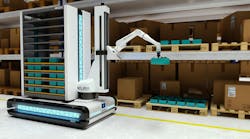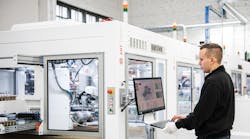The question that industries are asking today is: do we continue offshoring or should we consider reshoring? The right answer, according to Paavo Kakela, the CEO of EID Robotics, who provides modular micro-factory systems, is that manufacturers should transform their operations to right shoring. In this article, he explains the three steps you need to establish a profitable rightshoring model—a business case, strategy, and technology!
In the 1990s, the US manufacturers were sold by the lower cost of Asian labor. This is how the global offshoring boom started in Asia. In the millennium, offshoring peaked, and it maintained this growth trend until 2010—the year when the US domestic manufacturing employment rates reached the all-time lows.
Offshoring Troubles
How times have changed. Since then, manufacturing salaries in Asia have risen dramatically, and manufacturers have experienced the flip-side of cheap overseas production: these include low quality, high duties and taxes, expensive freight costs, bloated inventories, and long lead times. China’s 2017 National Intelligence Law, which requires Chinese companies to contribute to national intelligence, has made intellectual property thefts a nightmare. Environmental and social issues are causing substantial damage to manufacturers’ reputations. Lastly, the rise of protectionist policies and continuous global uncertainty has turned the tide for offshoring—it simply doesn’t guarantee profits anymore.
Rapid advancements in automation technologies, robotics, and predictive analytics have propelled reshoring since 2010 to become a more prominent alternative for offshoring.
According to pro-reshoring industry coalition, Reshoring Initiative, for the first time since 1970, reshoring generated more manufacturing jobs in 2016 in the US, than what was offshored overseas. In 2017, a record number of 170,000 manufacturing jobs were announced in the US. A year later, a total of 145,000 jobs were announced by 1,389 companies.
Benefits of Reshoring
The benefits of reshoring sound great. How can you, as manufacturer resist these perks: tax incentives, higher quality, shorter lead times, smaller inventories, while also meeting fluctuating customer demands quickly, easier collaboration, skilled and innovative workers, and protected intellectual property. Selling locally-made, premium-priced products, eliminating import duties, and reducing transportation costs can increase profits substantially.
So, the benefits of reshoring can eventually exceed the savings that firms get due to low overseas wages. Despite its lucrative benefits, however, reshoring is not as easy as you think.
Reshoring Challenges
Many companies have restored at least a part of their production. However, most companies still continue their manufacturing in Asia—simply because it’s often more cost-efficient, due to the vast infrastructure that has been built up in the region over the past decades.
Some countries have lost skilled manufacturing engineers, technicians, and tooling specialists as a result of offshoring. The recruitment could become a severe roadblock for large-scale reshoring. Further barriers include the high labor costs of the West, and, in turn, the expensive energy costs found in Europe.
Interestingly, a survey by the Manufacturing Group of the University of Warwick, which was conducted for the industry body, Reshoring UK, found that only 13% of companies have directly restored. However, 52% have reshored indirectly—this means, instead of rather bringing the bulk of production home, they built additional capacity at home.
Reshoring in large volumes to Europe or the US is difficult and costly. As a result, the forerunner industries have stopped thinking of whether to offshore or reshore. Instead, they have moved onto seeking strategies for rightshoring!
A smart rightshoring strategy can generate positive economic net-value and deliver a competitive advantage in the long-term and help to contribute to a more sustainable future.
How Can I Build a Profitable Rightshoring Model?
There is no single rightshoring model that works for every manufacturer. We developed a 3-step approach to plan rightshoring: this involves having a business case, a strategy, and technology. We suggest you start by calculating the Return on Investment (ROI) to see if there is a business case that will work for your company!
Business Case
Rightshoring is just like any other investment—it must pay back the initial costs, or otherwise, it's not worth pursuing. Calculate the ROI for local manufacturing to determine if reshoring makes economic sense for your company. Here are the three primary value contributors to consider:
Cost Savings due to Higher Quality
One of the biggest offshoring disappointments has been inferior product quality, which increases the costs in multiple ways—through customer reclamations, re-production, waste, and lost sales. For example, an LED tube manufacturer with an annual production capacity of one million units, could reduce the share of faulty units from 3.5 to 0.5% by moving production from a Chinese factory to a fully-automated micro-factory in the US.
Supply Chain Benefits
The simplified supply chain is a crucial benefit in rightshoring. It saves money because of the lower working capital. In the case of the LED tube manufacturer, the delivery time was reduced from 5 weeks to 1 week by radically streamlining the supply chain. You can stack up savings from reduced logistics costs, shorter lead times, more accurate forecasting, better flexibility, smaller inventories, and reduced waste and obsoletion.
Additional Sales through Higher Brand Value
As a local manufacturer, you can tag a Made in the USA or Made in Europe label on your products. Depending on the sector, the selling price for domestic products can be as high as double compared to imported products. Even in the commoditized LED tube market, the price of a local product was estimated to be 12% higher compared to Chinese products. Additionally, domestic products can sometimes open you to the public procurement markets.
Rightshoring Strategy
To create a rightshoring strategy in today's complicated, highly-competitive, and globally-networked world, is not easy. By asking yourself the right questions, it can help you approach the strategy—for example, by answering ‘yes’ to these questions might help you decide the case for reshoring or rightshoring:
- Do you want to protect your immaterial property rights by manufacturing locally? Or do you want to develop a new manufacturing process in conjunction with your R&D?
- Are you making high-margin, short-run products designed for local markets? Or are you serving multiple seasons with regional variations?
- Do you need to reduce lead times because of customized products, frequent updates, or highly variable regional demands?
- Does your company have a global system for sourcing raw materials with regional manufacturing, and local distribution?
- Do you have exceptionally high transport costs or are you transporting a lot of individual parts? Could you optimize costs by manufacturing pre-assembly modules near the needed raw materials if there were cost-efficient, highly-robotized micro-factories?
- Do you have significant production volumes, bulky or heavy products, energy-intensive manufacturing, or special logistics requirements?
Automation Technology
Let’s face it, reshoring or rightshoring won't work out simply by moving your overseas production lines home. Cost-efficient and competitive manufacturing in the Western continent requires a lean, centralized organization, one that is extensively robotized, with automated production, big data, and predictive maintenance algorithms.
By harnessing advanced manufacturing technologies, you can minimize the initial CAPEX and risks, reduce operational costs in the long run, and gain maximum flexibility in your operations.
Agility and scalability are crucial for efficient rightshoring. To get this right, you will need a modular micro-factory platform, which allows you to increase the investment gradually, in line with the actual demand. Micro-factory lines can be installed in one workday. If you need to change your product design suddenly, they allow for easy modifications and updates. You can add additional modules later if, for instance, testing or packaging is needed. The setup time for installing new modules can be counted in hours.
If there are several distribution plants involved, a Cloud-based control solution allows you to centralize the operational team and remotely support the on-site field engineers to guarantee minimum downtime in the process with lower OPEX.
When new, updated parts are needed, regardless of a different size or form factor, vision-guided general feeders can enable quick and easy changes to new parts.
For uninterrupted operation, big data is continuously collected from your product lines and analyzed in the Cloud. In case of any deviations in the process, problems can be fixed remotely before they stop the production line.
In Conclusion
Since the beginning of history, manufacturing has been in a continuous state of transformation. When the global offshoring boom came to its end, manufacturers quickly started to board the reshoring strategy. However, the world is becoming an ever-changing and complicated business environment. In the future, the winning manufacturers are those who are the quickest to harness the new technologies, including automation, robotics, and data analytics—and those who can carve out a smart, agile, and scalable rightshoring strategy!
About EID Robotics
EID Robotics, founded in 2009, is a global provider of automation solutions and the revolutionizer of the production industry. EID Robotics’ modular microfactory manufacturing concept, ANT Plant, is an industry innovation. The company is located in Kuopio, Finland. The company has an extensive track record in customer-focused industrial automation, especially in the fields of electronics, electrical work, and lighting. For more: https://eidrobotics.com/










